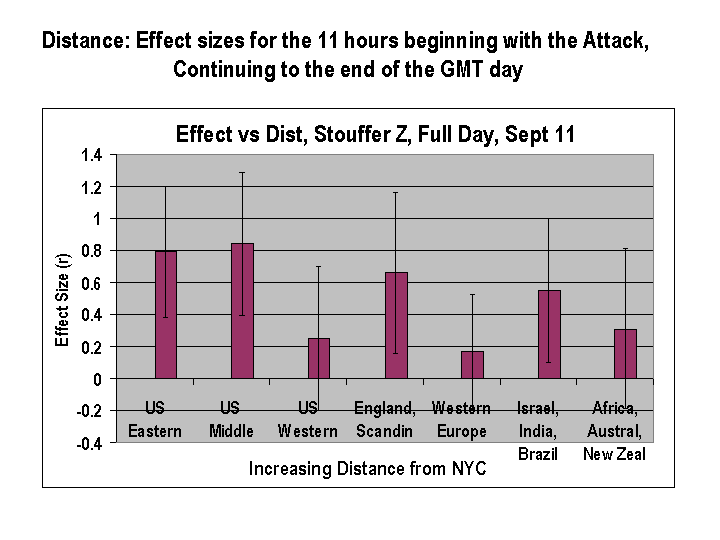|
A natural assumption that most of us tend to make is that the effects
will be strongest on nearby eggs. We are used to thinking about
electromagnetic effects, light, heat, etc. We transfer this knowledge,
and expect the changes in the REG data will fall off in proportion to
the geographic distance of the egg from the nominal source.
The experience of psi researchers suggests that in fact the effects may
be nonlocal, and undiminished by distance. Though it has previously not been
possible to do a careful assessment of this question, the GCP's
distributed network and long-continuing database enable an empirical
study, using two standard measures of effect.
This will be one of several parametric questions we will pursue
more comprehensively in the next few months.
A much more comprehensive look at the distance
issue is being developed,
based on the whole database of about 200 events.
The preliminary analysis shows significant evidence for a distance effect.
Preliminary indications are that although the effects are largely
nonlocal, this model will have to be carefully examined. In the most
thorough assessment we have made to date (late 2003), there is a
suggestion of some falloff of effect with distance.
The sharply defined data of Sept 11 2001 can be separated into a
few geographic categories, and when we do this we can see a modest,
though uneven, tendency to decline, especially in the Stouffer Z measure.
It isn't strong enough to be statistically significant,
because of the large error bars.
 The corresponding Device Variance measure is more ragged, but again there is
some suggestion of a decline.
Certainly if we had only the US eggs, the case would be persuasive, with
the largest effect in the East, declining to null in the middle states,
and actually going negative in the West-coast eggs. But data from most of the
rest of the world shows a positive average effect, smaller than in the
Eastern US.
The corresponding Device Variance measure is more ragged, but again there is
some suggestion of a decline.
Certainly if we had only the US eggs, the case would be persuasive, with
the largest effect in the East, declining to null in the middle states,
and actually going negative in the West-coast eggs. But data from most of the
rest of the world shows a positive average effect, smaller than in the
Eastern US.

|